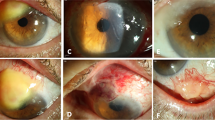Summary
A case is briefly described in which a typical conjunctivitis lignosa appeared after the eye had suffered lime burns.
In order to help clarify the morphological connection between mucopolysaccharide production and fiber development in the tumor tissue which occurred after the burn, samples were examined histologically, histochemically and with the use of the electron microscope.
The tumor had a cartilage like consistency. Its structure could be devided into three regions. Region A is the pseudo-membrane. It has root like extensions which anchor it to the underlying tissue, and which morphologically appear partially homogeneous and partially fibrous. Blood cells and cell remnants are included in the tissue of the pseudomembrane. The histochemical examination of the pseudomembrane did not present a uniform picture. Along with small amounts of dermatan-sulfate and chondroitin-sulfate B the membrane probably contained a rather large amount of hyaluronic acid.
The pseudomembrane borders on a granular tissue (Region B) which is distinguished by the wide metachromatic sheathes of the blood vessels found in it and the particularly large number of active fibroblasts along its edges. The silver impregnation method and the electronmicroscopic examination showed that the vascular sheathes consist of bundles of reticular fibers which constitute a three-dimensional network. A similar sort of sheath was observed around the fibroblasts. Chondroitin-sulfate makes up the largest fraction of the mucopolysaccharides near the fibers and appears particularly concentrated at the intersections of the fibers, although it is also diffusely distributed as well. Dermatan-sulfate (or heparan-sulfate) is found only in the mucopolysaccharide sheath of the fibers themselves.
The deep region of the tumor (Region C) consists almost exclusively of blood vessels, their sprouts and the fibroblasts which, with their wide fibrous sheathes, almost fill the spaces between the blood vessels. The reticular fibers and their mucopolysaccharide sheathes have the same structure as that observed in Region B.
The fact that the mucopolysaccharides did not appear in plaques but rather as bound primarily to the fibers is grounds for suggesting that a fiber development disorder, probably stemming from the pericytes and fibroblasts rich in ergastoplasm and fibrilles, could play the principle role in conjunctivitis lignosa. The cartilagen like consistency of the tumor could be a result of the arrangement of the fibers and their mucopolysaccharide sheathes.
Brief remarks are included concerning the therapeutic consequences of the study.
Zusammenfassung
Bei einem Patienten trat nach einer Kalkverätzung eine typische Conjunctivitis lignosa auf, die kurz beschrieben wird.
An exidiertem Material wurden histologische, elektronen-mikroskopische und histochemische Untersuchungen durchgeführt mit dem Ziel, die morphologische Beschaffenheit des in der Konsistenz knorpelartigen Tumors darzustellen und eine morphologische Beziehung zwischen Mucopolysaccharidbildung und Faserbildung näher zu klären. Der Aufbau des Tumors ließ sich in drei Abschnitte unterteilen: Zone A, die Pseudomembran, die sich mit bälkchenartigen Ausläufern in dem darunterliegenden Gewebe verankert und morphologisch aus teils homogen, teils faserig erscheinendem Material besteht, in das Blutzellen und Zellreste eingeschlossen sind. Auch die histochemische Untersuchung ergab kein einheitliches Bild: neben geringen Mengen von Dermatansulfat und Chondroitinsulfat B enthält die Pseudomembran wahrscheinlich größere Mengen von Hyaluronsäure.
An die Pseudomembran grenzt ein Granulationsgewebe (Zone B) an, das durch seine breiten metachromatischen Gefäßscheiden und durch die am Tumorrand besonders zahlreichen und aktiven Fibroblasten auffällt. Die Silberimprägnationsmethode und die elektronen-mikroskopische Untersuchung zeigte, daß die Gefäßscheiden aus Bündeln reticulärer Fasern bestehen, die in den verschiedenen Richtungen des Raumes verlaufen. Auch die Fibroblasten zeigen eine derartige Faserhülle. Die Mucopolysaccharide in der Umgebung der Fasern enthalten als stärkste Fraktion Chondroitinsulfat, das besonders an den Kreuzungsstellen der Fasern auch diffus verteilt vorkommt, während Dermatansulfat bzw. Heparansulfat nur in der Mucopolysaccharidhülle der Fasern selbst enthalten ist.
Die tiefe Region C des Tumors besteht fast ausschließlich aus Gefäßen, Gefäßsprossen und Fibroblasten mit ihren breiten Faserhüllen, die damit fast den gesamten Zwischenraum zwischen den Gefäßen ausfüllen. Diese reticulären Fasern mit ihren Mucopolysaccharidhüllen zeigen den gleichen Aufbau wie in Zone B beschrieben.
Die Tatsache, daß die Mucopolysaccharide nicht in „Plaques“, sondern hauptsächlich an Fasern gebunden auftreten, läßt vermuten, daß bei der Conjunctivitis lignosa eine Faserbildungsstörung im Vordergrund steht, für die wahrscheinlich die ergastoplasma- und fibril-lenreichen Fibroblasten und Pericyten verantwortlich gemacht werden können. Die knorpelartige Konsistenz könnte auf der Anordnung der Fasern zusammen mit ihrer Mucopoly-saccharidhülle zurückzuführen sein.
Kurze Überlegungen über therapeutische Konsequenzen werden angestellt.
Similar content being viewed by others
Literatur
François, J., Viotoria-Troncoso, V.: Treatment of ligneous conjunctivitis. Amer. J. Ophthal. 65, 674–678 (1968)
Gärtner, J.: Zur Therapie und Pathogenese der Konjunktivitis lignosa. Albrecht v. Graefes Arch. klin. exp. Ophthal. 190, 229–247 (1974)
Kanai, A., Pollak, F. M.: Histologie and electron microscopic studies of ligneous conjunctivitis. Amer. J. Ophthal. 72, 909–916 (1971)
Movat, H. C.: Silverimprägnationsmethodes for electron microscopy. Amer. J. clin. Path. 35, 528–537 (1961)
Nover: Über die als Conjunctivitis lignosa bezeichnete chronische pseudomembranöse Bindehautentzündung. Klin. Mbl. Augenklinik. 145, 221–233 (1964)
Reynolds, S. E.: The use of lead citrate at high pH as an electron opaque stain in electron microscopy. J. Cell Biol. 17, 208 (1963)
Richardson, K. C., Jarett, L., Finke, E. H.: Embedding in epoxy resins for ultrathin sectioning in electron microscopy. Stain Technol. 35, 313 (1960)
Scott, J. E., Dorling, J.: Differential staining of acid glycosaminoglycans (mucopolysaccharid) by alcian blue in salt solutions. Histochemie 5, 221–233 (1965)
Author information
Authors and Affiliations
Additional information
Mit Unterstützung der Stiftung Volkswagenwerk.
Rights and permissions
About this article
Cite this article
Lütjen-Drecoll, E., Sames, K., Straub, W. et al. Klinische, elektronenmikroskopische und histochemische Untersuchungen bei Conjunctivitis lignosa. Albrecht von Graefes Arch. Klin. Ophthalmol. 194, 175–191 (1975). https://doi.org/10.1007/BF00496874
Received:
Issue Date:
DOI: https://doi.org/10.1007/BF00496874




